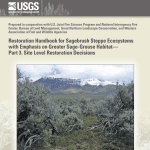Restoration handbook for sagebrush steppe ecosystems with emphasis on greater sage-grouse habitat—Part 3. Site level restoration decisions

View handbook.
This handbook walks managers and practitioners through a number of site-specific decisions managers face before selecting the appropriate type of restoration. This site-level decision tool for restoration of sagebrush steppe ecosystems is organized in nine steps.
- Step 1 describes the process of defining site-level restoration objectives.
- Step 2 describes the ecological site characteristics of the restoration site. This covers soil chemistry and texture, soil moisture and temperature regimes, and the vegetation communities the site is capable of supporting.
- Step 3 compares the current vegetation to the plant communities associated with the site State and Transition models.
- Step 4 takes the manager through the process of current land uses and past disturbances that may influence restoration success.
- Step 5 is a brief discussion of how weather before and after treatments may impact restoration success.
- Step 6 addresses restoration treatment types and their potential positive and negative impacts on the ecosystem and on habitats, especially for greater sage-grouse. We discuss when passive restoration options may be sufficient and when active restoration may be necessary to achieve restoration objectives.
- Step 7 addresses decisions regarding post-restoration livestock grazing management.
- Step 8 addresses monitoring of the restoration; we discuss important aspects associated with implementation monitoring as well as effectiveness monitoring.
- Step 9 takes the information learned from monitoring to determine how restoration actions in the future might be adapted to improve restoration success.

